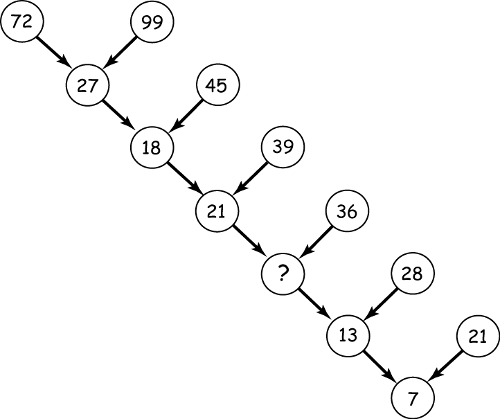
A conundrum by the late brilliant Japanese puzzle maven Nob Yoshigahara.
Lee Sallows writes, “You have to solve this yourself, otherwise you won’t see how beautiful it is.”

A conundrum by the late brilliant Japanese puzzle maven Nob Yoshigahara.
Lee Sallows writes, “You have to solve this yourself, otherwise you won’t see how beautiful it is.”
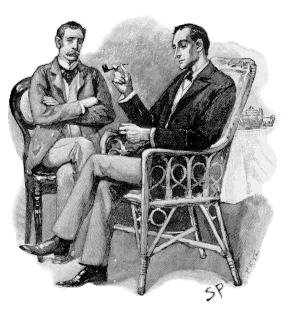
A.B. Cox, in Jugged Journalism (1925), suggested that Arthur Conan Doyle might hand over the writing of a Sherlock Holmes story to P.G. Wodehouse:
Holmes and the Dasher
It was a pretty rotten sort of day in March, I remember, that dear old Holmes and I were sitting in the ancestral halls in Baker Street, putting in a bit of quiet meditation. At least Holmes was exercising the good old grey matter over a letter that had just come, while I was relaxing gently in an arm-chair.
‘What-ho, Watson, old fruit,’ he said at last, tossing the letter over to me. ‘What does that mass of alluvial deposit you call a brain make of this, what, what?’
“The letter announces that Cissie Crossgarters will be rolling round to see jolly old Holmes,” explains Richard Lancelyn Green in The Sherlock Holmes Letters. “It is all dashed rotten and pretty thick, but when Holmes has splashed a little soda into his glass of cocaine, he heaves himself out of his chair and trickles out to her. ‘What ho!’ says Bertie Watson when Holmes returns. Everything is top-hole and the chappie Holmes announces that Cissie and he are engaged to be married.”
Miles Kington once wrote a Holmes adventure in blank verse — it’s called “The Case of the Danish Prince”:
SHER: But here, unless I'm much mistook, comes one
That needs our aid. A case at last!
(Enter to them HAMLET)
HAM: Which one --
SHERL: Of us is Holmes? 'Tis I. This gentle here
Is Watson, my devoted friend and colleague.
HAM: Good morrow to you both. You do not know me --
SHERL: Apart from knowing that you are a prince,
From Denmark, I would hazard, and a solitary,
That you take snuff, have lately been at sea,
Were frightened by a horse at five and now
Are sitting for your portrait, you are a stranger.
WATS: Good heavens, Holmes!
The full text is here.

In 1959, Dallas journalist John Howard Griffin used drugs and sunlamps to darken his skin and then traveled through Louisiana, Mississippi, Alabama, and Georgia posing as a black man and keeping a diary of his experiences. He found it to be “the story of the persecuted, the defrauded, the feared and the detested.” When he applied for work at a plant in Mobile, the foreman told him, “No, you couldn’t get anything like that here.”
His voice was not unkind. It was the dead voice one often hears. Determined to see if I could break in somehow, I said: ‘But if I could do you a better job, and you paid me less than a white man …’
‘I’ll tell you … we don’t want you people. Don’t you understand that?’
‘I know,’ I said with real sadness. ‘You can’t blame a man for trying at least.’
‘No use trying down here,’ he said. ‘We’re gradually getting you people weeded out from the better jobs at this plant. We’re taking it slow, but we’re doing it. Pretty soon we’ll have it so the only jobs you can get here are the ones no white man would have.’
‘How can we live?’ I asked hopelessly, careful not to give the impression I was arguing.
‘That’s the whole point,’ he said, looking me square in the eyes, but with some faint sympathy, as though he regretted the need to say what followed: ‘We’re going to do our damnedest to drive every one of you out of the state.’
In a Mississippi bus station he felt a “hate stare” that would grow familiar. “It came from a middle-aged, heavyset, well-dressed white man. He sat a few yards away, fixing his eyes on me. Nothing can describe the withering horror of this. You feel lost, sick at heart before such unmasked hatred, not so much because it threatens you as because it shows humans in such an inhuman light. You see a kind of insanity, something so obscene the very obscenity of it (rather than its threat) terrifies you. It was so new I could not take my eyes from the man’s face. I felt like saying: ‘What in God’s name are you doing to yourself?'”
Two weeks before Charles Lindbergh’s famous flight, a pair of French aviators attempted a similar feat. Their brave journey might have changed history — but they disappeared en route. In this week’s episode of the Futility Closet podcast we’ll follow the flight of the “White Bird” — and ponder what became of it.
We’ll also examine a proposal to build hippo ranches in the Louisiana bayou in 1910, investigate historical outbreaks of dancing, laughing, and other strange behavior, and present the next Futility Closet challenge.
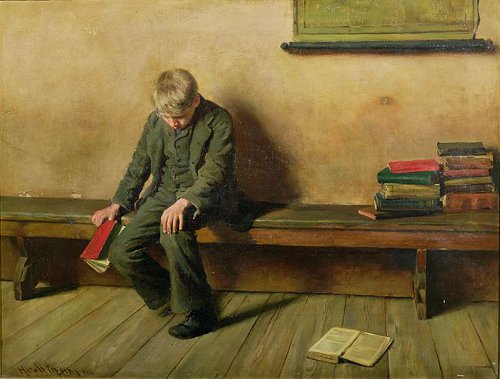
“It is disconcerting to reflect on the number of students we have flunked in chemistry for not knowing what we later found to be untrue.” — Attributed to Deming by B.R. Bertramson, in Robert L. Weber, Science with a Smile, 1992
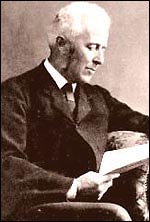
Sherlock Holmes was based on a real man, Scottish surgeon Joseph Bell, whom Arthur Conan Doyle had served as a clerk in the Edinburgh Royal Infirmary.
Bell was famous for making deductions about his patients. He greeted one by saying, “Ah, I perceive that you are a soldier, a noncommissioned officer, and that you have served in Bermuda.”
When the man acknowledged this, Bell addressed his students. “How did I know that, gentlemen? The matter is simplicity itself. He came into the room without taking his hat off, as he would go into an orderly’s room. He was a soldier. A slight authoritative air, combined with his age, shows that he was a noncommissioned officer. A slight rash on the forehead tells me that he was in Bermuda, and subject to a certain rash known only there.”
On another occasion Bell challenged his students to identify a bitter drug by taste alone. They watched him dip a finger into the tumbler and taste it, and reluctantly followed suit. “Gentlemen,” he said with a laugh, “I am deeply grieved to find that not one of you has developed this power of perception which I so often speak about; for if you had watched me closely, you would have found that while I placed my forefinger in the medicine, it was the middle finger which found its way into my mouth.”
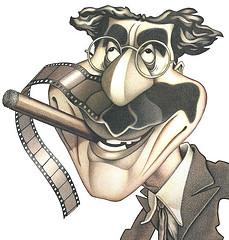
In 1961, when Groucho Marx turned 71, he received a telegram from Irving Berlin:
THE WORLD WOULD NOT BE IN SUCH A SNARL
HAD MARX BEEN GROUCHO INSTEAD OF KARL.
In 1994, computer scientists Graeme Ritchie and Kim Binsted designed a computer program to generate original riddles:
They called it JAPE, for Joke Analysis and Production Engine. In 1997 they convened a group of 8- to 11-year-old children to act as judges and presented them with a random selection of JAPE-produced riddles, human-produced riddles, nonsense nonjokes, and sensible nonjokes. Then they asked them to decide whether each text was a joke and, if so, how funny it was and whether they had heard it before.
“The results showed that the JAPE-produced riddles were identified as jokes just as reliably as the human-produced ones, and both were easily distinguished from the non-jokes,” writes Rod Martin in The Psychology of Humor (2007). “Although the JAPE-produced jokes were rated as less funny, on average, than the human-produced jokes, a number of the JAPE riddles were rated as being just as funny as those produced by humans.”
(Binsted, K., Pain, H., & Ritchie, G., “Children’s Evaluation of Computer-Generated Punning Riddles,” Pragmatics and Cognition, 5(2) [1997], 309-358.)
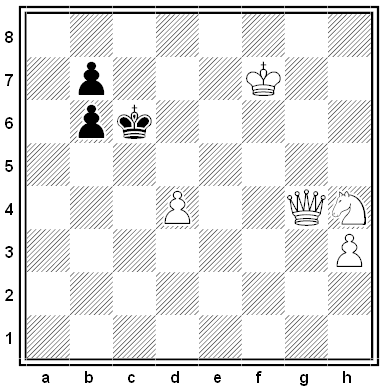
A cylindrical problem by Miodrag Petkovic: Imagine that the board is rolled into a cylinder, with the a-file adjoining the h-file. How can White mate in two moves?
In 1961, Robert Rauschenberg was invited to participate in a Paris show in which artists were to exhibit a portrait of gallery owner Iris Clert. Rauschenberg sent a telegram:
THIS IS A PORTRAIT OF IRIS CLERT IF I SAY SO
Was he right? Perhaps so: Three years later, Parisian performance artist Ben Vautier sat down in a street in Nice holding a placard in his lap. The placard read:
Regardez moi cela suffit je suis art.
That means, “Look at me. That’s all it takes; I’m art.”